1509 Esclangona, provisional designation 1938 YG, is a rare-type Hungaria asteroid and binary system from the inner regions of the asteroid belt, approximately 8 kilometers in diameter. It is named after French astronomer Ernest Esclangon.

Parthenope is a large, bright main-belt asteroid.
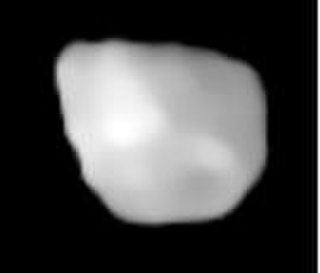
Egeria is a large main-belt G-type asteroid. It was discovered by Annibale de Gasparis on November 2, 1850. Egeria was named by Urbain Le Verrier, whose computations led to the discovery of Neptune, after the mythological nymph Egeria of Aricia, Italy, the wife of Numa Pompilius, second king of Rome.
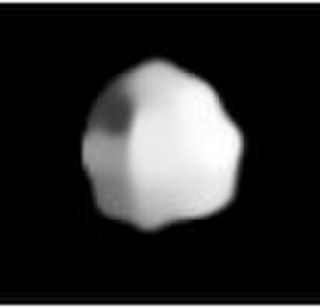
Melpomene is a large, bright main-belt asteroid that was discovered by J. R. Hind on 24 June 1852, and named after Melpomenē, the Muse of tragedy in Greek mythology. Its historical symbol was a dagger over a star; it is in the pipeline for Unicode 17.0 as U+1CECB .

Amphitrite is one of the largest S-type asteroids, approximately 200 kilometers in diameter, and probably fifth largest after Eunomia, Juno, Iris and Herculina.
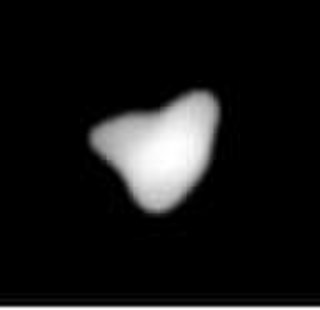
Urania is a large main-belt asteroid that was discovered by English astronomer John Russell Hind on July 22, 1854. It was his last asteroid discovery. This object is named after Urania, the Greek Muse of astronomy. Initial orbital elements for 30 Urania were published by Wilhelm Günther, an assistant at Breslau Observatory. It is orbiting the Sun with a period of 3.64 years and is spinning on its axis once every 13.7 hours.

Pomona is a stony main-belt asteroid that is 81 kilometres (50 mi) in diameter. It was discovered by German-French astronomer Hermann Mayer Salomon Goldschmidt on October 26, 1854, and is named after Pōmōna, the Roman goddess of fruit trees.

Laetitia is a large main-belt asteroid that was discovered by French astronomer Jean Chacornac on 9 February 1856 and named after Laetitia, a minor Roman goddess of gaiety. The spectrum matches an S-type, indicating a stony (silicate) composition. It is orbiting the Sun with a period of 4.61 years and is spinning on its axis once every 5.1 hours.
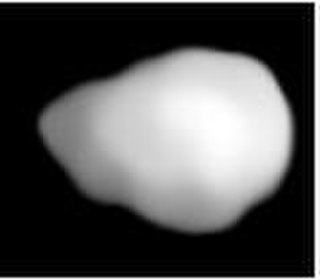
Daphne is a large asteroid from the asteroid belt. It is a dark-surfaced body 174 km in diameter is probably composed of primitive carbonaceous chondrites. The spectra of the asteroid displays evidence of aqueous alteration. It was discovered by H. Goldschmidt on May 22, 1856, and named after Daphne, the nymph in Greek mythology who was turned into a laurel tree. Incorrect orbital calculations initially resulted in 56 Melete being mistaken for a second sighting of Daphne. Daphne was not sighted again until August 31, 1862.

Hestia is a large, dark main-belt asteroid. It is also the primary body of the Hestia clump, a group of asteroids with similar orbits.

Diana is a large and dark main-belt asteroid. It was discovered by German astronomer Robert Luther on March 15, 1863, and named after Diana, Roman goddess of the hunt. The asteroid is orbiting the Sun at a distance of 2.620 AU with a period of 4.24 years and an eccentricity (ovalness) of 0.207. The orbital plane is tilted at an angle of 8.688° relative to the plane of the ecliptic. Its composition is carbonaceous and primitive.

Artemis is a main-belt asteroid that was discovered by J. C. Watson on September 16, 1868, at Ann Arbor, Michigan. It was named after Artemis, the goddess of the hunt, Moon, and crossways in Greek Mythology.

168 Sibylla is a large main-belt asteroid, discovered by Canadian-American astronomer J. C. Watson on September 28, 1876. It was most likely named for the Sibyls, referring to the Ancient Greek female oracles. Based upon its spectrum this object is classified as a C-type asteroid, which indicates it is very dark and composed of primitive carbonaceous materials. 168 Sibylla is a Cybele asteroid, orbiting beyond most of the main-belt asteroids.
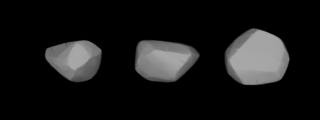
Nausikaa is a large main-belt S-type asteroid. It was discovered by Johann Palisa on February 17, 1879, at Pula, then in Austria, now in Croatia. The name derives from Nausicaä, a princess in Homer's Odyssey.

Prokne is a main-belt asteroid that was discovered by German-American astronomer C. H. F. Peters on March 21, 1879, in Clinton, New York, and named after Procne, the sister of Philomela in Greek mythology. Stellar occultations by Prokne have been observed twice, in 1984 from Italy and again in 1999 from Iowa.

532 Herculina is a large asteroid, with a diameter of around 200 km.
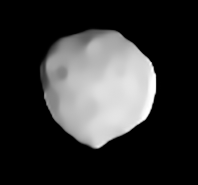
Bamberga is one of the largest asteroids in the asteroid belt. It was discovered by Johann Palisa on 25 February 1892 in Vienna. It is one of the top-20 largest asteroids in the asteroid belt. Apart from the near-Earth asteroid Eros, it was the last asteroid which is ever easily visible with binoculars to be discovered.

Dembowska is a large asteroid of the main belt, discovered on 9 December 1892, by the French astronomer Auguste Charlois while working at the observatory in Nice, France. It is named in honor of the Baron Hercules Dembowski, an Italian astronomer who made significant contributions to research on double and multiple stars.
1994 Shane, provisional designation 1961 TE, is a dark Adeonian asteroid from the central region of the asteroid belt, approximately 25 kilometers in diameter.
1776 Kuiper, provisional designation 2520 P-L, is a dark Eoan asteroid from the outer region of the asteroid belt, approximately 38 kilometers in diameter.

















